cThe Internet of Things (IoT) is a concept that has the potential to revolutionize the way we live, work, and interact with our environment. Today, more and more new and established businesses are utilizing the power of IoT to create innovative products and services. Because of this shift, interconnectedness has become an intrinsic part of our lives, with technology aiding and enabling us to do more than ever before.
As a startup working in software development consultancy, Aloa is dedicated to giving businesses a comprehensive understanding of the emerging technologies that will shape their future. With our expertise, we can guide them in leveraging the power of such technology to create innovative products and services.
In this IoT overview article, we’ll start by answering the question, “What exactly does IoT entail, and how does it impact you as a business owner?". We'll also touch on the security concerns surrounding IoT and the potential for data privacy violations. Finally, we'll discuss how you can use this technology to create new products and services for your business.
Let's dive in!
What is the Internet of Things (IoT)? An IoT Overview:
IoT is an architecture that connects physical devices with each other using a network such as the Internet. Devices running on different operating systems can communicate with each other through the network, allowing them to share information, control connected devices, and automate processes. In a business setting, IoT monitors pre-existing operations and creates new ones.
IoT comprises several key components that create a seamless and interconnected ecosystem. These components include:

- Sensors and Actuators: Sensors collect data from the environment, such as temperature, humidity, or light levels, while actuators perform actions based on this data, like turning on a fan or adjusting the brightness of a light.
- Connectivity: Devices connect to the internet to exchange data. Connectivity occurs through various means, such as Wi-Fi, Bluetooth, cellular networks, or satellite communication.
- Data Processing and Storage: Devices generate vast amounts of data that must be processed and stored. This can be done on the device itself (edge computing) or sent to a central server or cloud platform for processing and storage.
- Analytics and Machine Learning: Advanced analytics and machine learning algorithms can be applied to the collected data to identify patterns, make predictions, and optimize processes.
- User Interface: IoT devices often come with a user interface, such as a mobile app or web dashboard, that allows users to monitor, control, and interact with the connected devices.
These devices all connect to the internet and can communicate with each other, allowing for seamless information exchange between different systems and applications. For these devices to interact with each other, you'll need specific technologies to enable the exchange, such as:
- Cloud services like AWS, Azure, and Google Cloud store and process data from IoT devices.
- Wireless communication protocols like Wi-Fi, Bluetooth, and cellular networks allow devices to send and receive data without a physical connection.
- Connectivity protocols like MQTT and CoAP enable devices to communicate with each other over a network. An MQTT message broker, for instance, plays a pivotal role in managing and routing these communications efficiently, ensuring that IoT devices can exchange information seamlessly.
- Big data analysis, such as Artificial Intelligence (AI) and Machine Learning (ML) algorithms that allow devices to analyze real-time data and make decisions based on it, is then used to unlock insights from large datasets IoT sensors collect.
Using these internet-connected technologies, businesses can create connected systems to monitor and control their operations remotely. The potential applications of IoT services in a business setting are nearly limitless. From connected manufacturing processes to automated customer service, the Internet of Things creates new opportunities for businesses to gain an edge over their competition.
In its simplest terms, the Internet of Things (IoT) refers to physical objects around us connected to the Internet and can send and receive data. This means everyday objects like cars, thermostats, and clothes can have built-in sensors to communicate with other devices, people, or the internet. Such a technological leap has made its mark as the fourth industrial revolution, making it the next step in digital transformation.
How Does IoT Work?
The first thing to do is to look at how each part of the ecosystem works together. The main components of an IoT system are sensors, actuators, and devices that communicate with each other over a network.
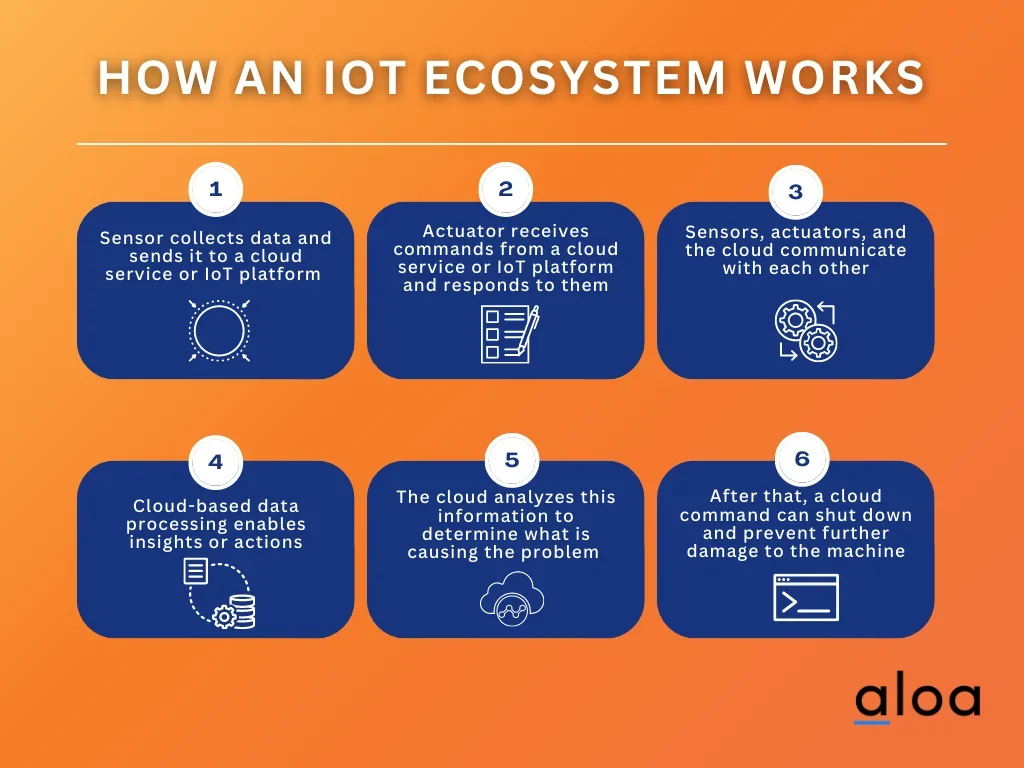
Sensors collect data from the environment and send it to an IoT platform or cloud service for processing. Actuators receive commands from the cloud service or an IoT platform and act on them, such as turning on a light or sending a notification to the user.
Data is sent back and forth between sensors, actuators, and the cloud using various communication technologies like Wi-Fi, Bluetooth, LoRaWAN, Zigbee, Z-Wave, and cellular networks. These protocols allow for efficient data transfer and low latency, making them ideal for IoT applications. To fully leverage these communication protocols, businesses can benefit from customized IoT app development services, which ensure seamless integration and enhanced functionality for IoT ecosystems.
Once the data is collected and processed in the cloud, it can create insights or trigger an action. For example, the sensor data on a factory machine may detect vibrations that indicate a malfunction.
This information is sent to the cloud, where it can be analyzed to determine what's causing the issue. The cloud can then send a command to an actuator on the machine, instructing it to shut down and prevent further damage.
How To Implement IoT in Business
Implementing IoT in business requires you to develop a comprehensive strategy that includes understanding the technologies involved, how they can be used to benefit the organization's operations, and what it will take to implement a successful solution. Before you begin implementing IoT in your business, make sure you run through a few prerequisite steps first:
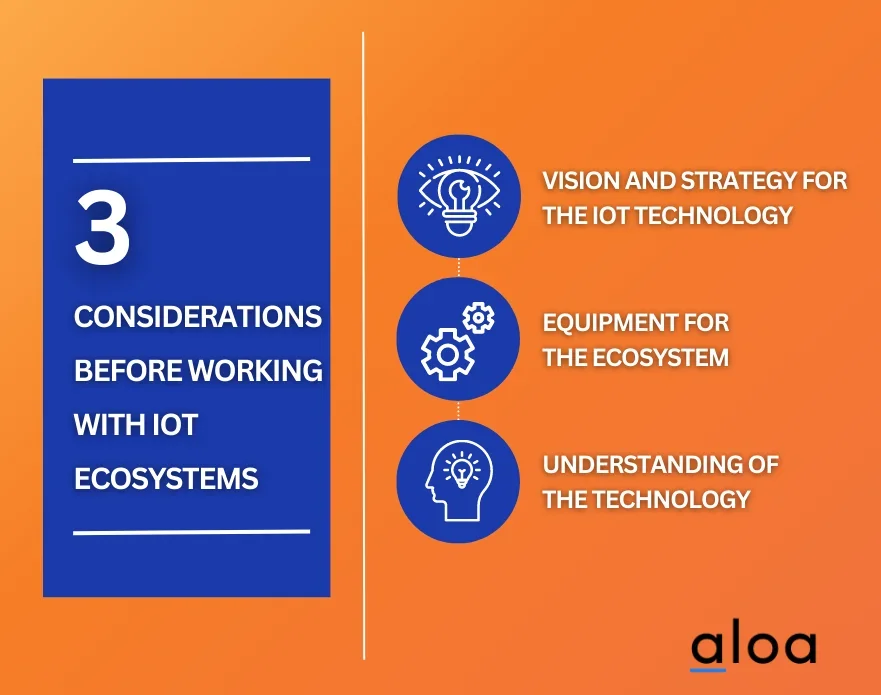
Establish a clear vision and strategy for the role of IoT.
Your vision and strategy should include the goals you want to accomplish with IoT and a plan for how you will integrate them into your operations. In establishing a clear vision and strategy, think about the specific use cases of the IoT system and decide whether it’s an effective use of your resources and time.
Understand the technologies you'll require and how they'll interact.
You'll need to know which devices, communication protocols, and cloud services you'll use. It's also essential to understand how the various components will interact with one another to create a successful IoT system. With this knowledge, it'll be easier to develop an effective solution.
Identifying which devices need to be connected, what data needs to be collected, and where it will be stored.
Once you know which technologies to use, you'll need to figure out what specific devices connect and what data you'll collect. You'll also have to determine where the data will be stored, whether on the device or in the cloud.
Once you've identified and addressed these prerequisites, you can implement IoT in your business. With that, here are the steps to take if you want to implement IoT into your business:
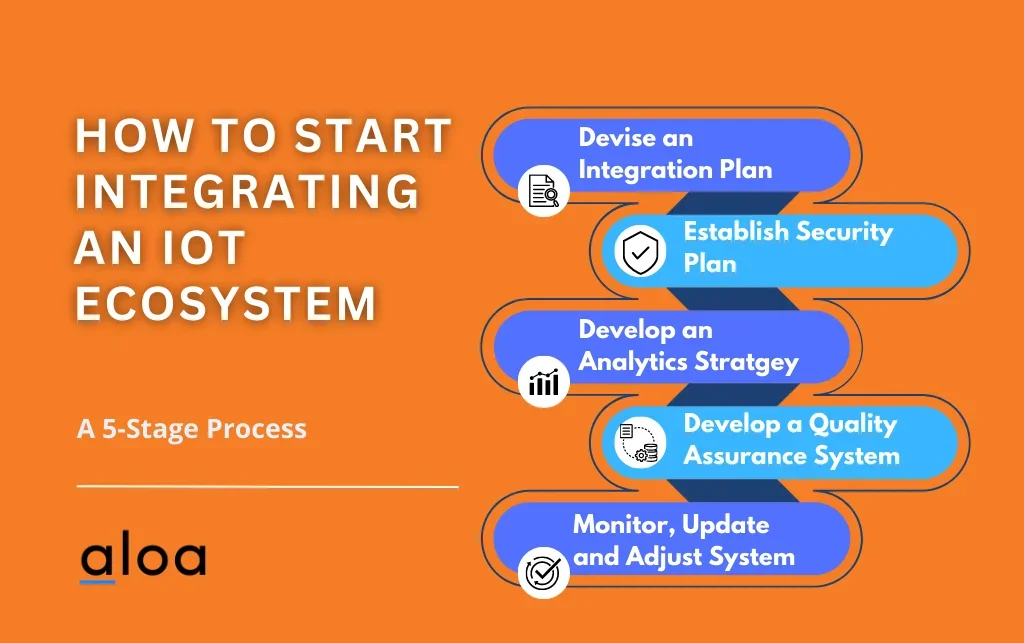
Step 1: Devise an Implementation Plan
An implementation plan should include a timeline of when and how the different components will be developed, tested, and deployed. The plan should also account for budget constraints and any potential roadblocks that could arise during the development process. Ideally, you'll also include an IoT architecture, the structure used to integrate all the different components of an IoT system, including devices, communication protocols, and cloud services. Your architecture will also include a plan for IoT device management, making it easier to pinpoint the roles and expectations for each device in the system.
Step 2: Establish a Security Plan
As with any other system, security is always a significant concern. You'll need to ensure that your devices are adequately secured and that data is encrypted in transit and at rest. This will ensure confidential information isn't compromised and protect against unauthorized access. Part of your security plan should also include regular updates to the firmware and software that run on connected devices.
Step 3: Develop an Analytics Strategy
Part of what makes the Internet of Things so powerful is its ability to collect and analyze large amounts of data. Having so much data may get overwhelming, so developing an analytics strategy that covers which type of data you collect, how it's used, and any potential insights gained from the analysis comes in handy. Your analytics strategy enables your business to weed out unnecessary data and focus on the most important insights that prove helpful to your current needs as a business.
Step 4: Creating a Quality Assurance System for Technical Issues
Whether hardware or software-related, technical issues are inevitable with any system. When they do arise, you'll need to ensure that your team is adequately trained and equipped to handle them promptly. Setting up a support system with remote access for troubleshooting and frequent updates can help minimize outages and downtime.
The ideal way to go about setting up a support system is to implement a quality assurance mechanism that enables you to take preemptive measures to proactively monitor and maintain your system. These quality assurance measures can help catch issues before they become serious problems. These include things like:
- Performing regular security audits.
- Conducting employee training sessions.
- Monitoring any suspicious activities on your networks.
Step 5: Regularly monitor, update, and adjust your IoT system
Once you have your Internet of Things system up and running, it's essential to regularly monitor its performance. This includes checking for any anomalies in the data collected by your sensors, any changes to the configuration of connected devices, or any unexpected behavior from your actuators. Keeping an eye on these metrics helps ensure that the system functions as intended and can help you quickly identify and address any issues.
IoT Technologies In Business
IoT plays a crucial role in providing valuable insights and automating processes in a business setting. Businesses can gain greater visibility into their operations by connecting machines and devices and making better decisions. They can also automate mundane tasks, freeing resources to focus on more strategic objectives.
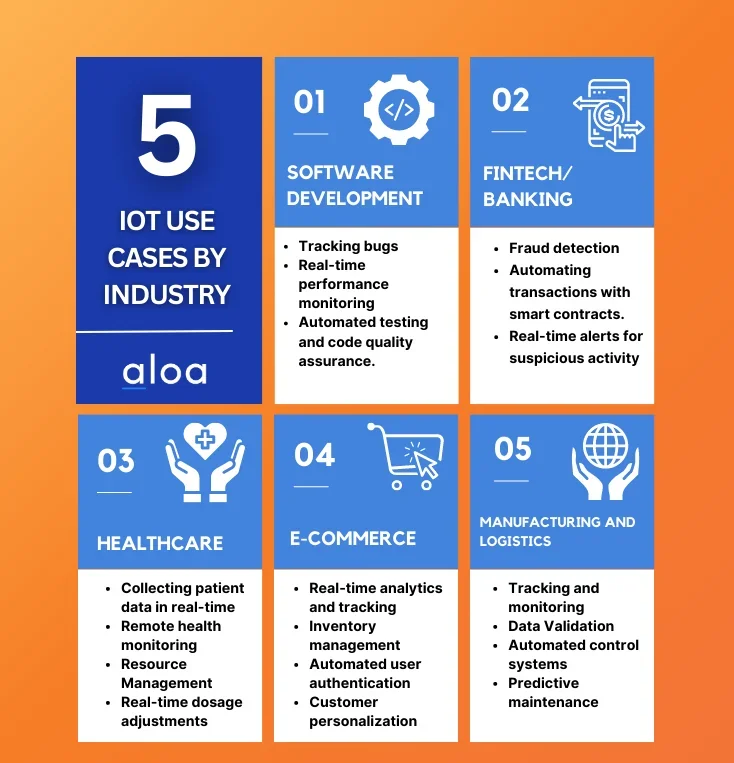
Software Development
Software development tools such as sensors and beacons can be used to track data and process it into meaningful insights. This data can then be used to build custom applications tailored to the needs of a particular business. For developers, using IoT provides the following benefits:
- Tracking errors and bugs remotely.
- Monitoring software performance in real-time.
- Automated testing and code quality assurance.
Fintech
The fintech industry has increasingly adopted IoT to improve the customer experience and automate processes. With that, businesses in the industry can streamline operations and reduce costs. Some of the ways companies can benefit from the Internet of Things include:
- Fraud detection by collecting data from various sources.
- Automating payments and transactions with smart contracts.
- Real-time alerts for customers when suspicious activity is detected.
Healthcare
IoT devices like wearables and remote monitoring systems can track and analyze patient data, enabling healthcare providers to offer personalized and proactive care. IoT can also be used to create smart hospitals, where connected devices and systems improve patient experiences, streamline operations, and enhance patient safety in situations like:
- Collecting patient data in real-time for better diagnosis accuracy.
- Connecting patients to medical professionals via remote health monitoring services.
- Managing healthcare resources such as hospital beds more efficiently using sensors.
- Creating intelligent drug delivery systems that adjust dosages according to patients' needs.
E-commerce
E-commerce businesses can leverage IoT to improve customer experiences and increase operational efficiency. In doing so, they can provide better services to their customers while saving on costs. Some of the ways that e-commerce businesses can use IoT include:
- Real-time analytics and tracking for better customer service.
- Inventory management solutions to automate ordering and restocking.
- Automated user authentication systems to ensure secure remote access to data.
- Using AI and ML to personalize product recommendations for customers.
Manufacturing and Logistics
The manufacturing industry uses the Internet of Things to create smart factories, where connected devices monitor and control production processes, optimize resource usage with techniques such as advanced gas metering, and ensure product quality. Industrial IoT can also enable predictive maintenance, where data from sensors predicts when equipment will require maintenance or repair, reducing downtime and maintenance costs. Specifically, the use cases for the manufacturing industry are:
- Tracking and monitoring of the supply chain and production processes in real time.
- Analyzing data from various sources for better decision-making.
- Creating automated control systems that can adjust according to changing conditions.
- Predictive maintenance to identify potential issues before they become serious problems.
Precautions To Take When Using IoT For Business
While IoT is a powerful tool for businesses, taking the necessary precautions when deploying IoT solutions is essential. Generally, precautions revolving around IoT focus on security measures that businesses must take to safeguard their sensitive data and ensure they do not impede on the sensitive data of their competitors or customers. With that in mind, let's look into the key IoT security measures businesses should take:
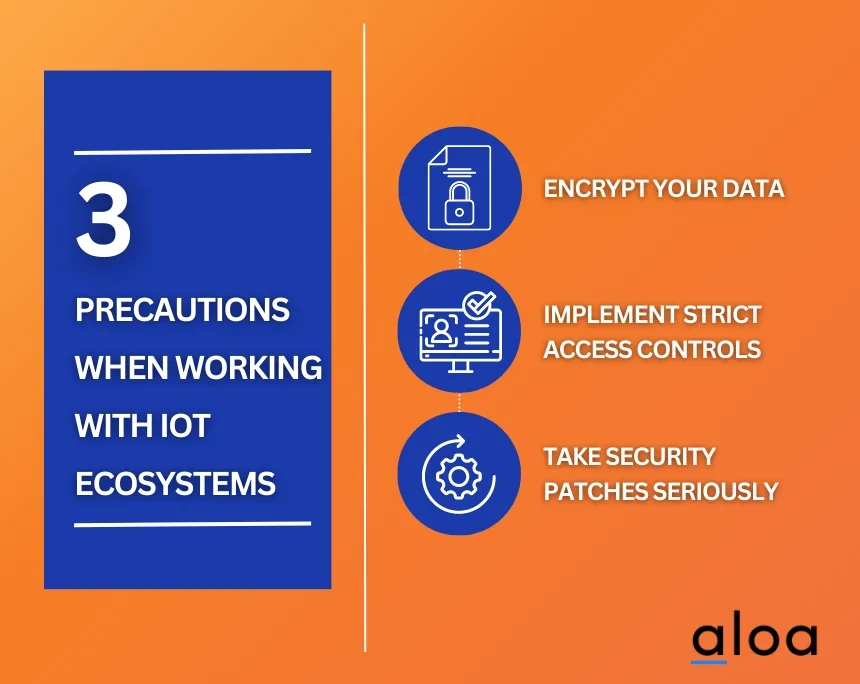
Encrypt Your Data
Businesses should ensure that their Internet of Things devices and systems are well-secured against attackers. Implementing authentication protocols, encryption techniques, and other security measures can help protect data from being stolen or manipulated. Businesses should also consider using secure communication protocols like TLS or IPSec to protect against eavesdropping and data leakage.
Implement Strict Access Controls
Having strong access control prevents businesses and customer data from being accessed by unauthorized personnel. Companies can implement two-factor authentication, role-based access control protocols, and other security measures to ensure that only approved users can access sensitive data.
Businesses should also know the potential privacy risks associated with collecting customer data. They should implement safeguards to ensure that customers' data is not used without their consent and is protected from unauthorized access or manipulation.
Don't Skip Out On Security Patches
Ensure all IoT devices are regularly maintained and updated with the latest security patches. Businesses should ensure all their devices are frequently monitored for vulnerabilities and updated with the latest security patches and bug fixes. Doing so will help protect their systems against potential attack vectors, like malware or ransomware.
Finally, businesses should consider creating an emergency response plan for any disruptions caused by IoT device malfunctions or security breaches. A plan will help minimize the potential impact of such events and get the organization back on track as quickly as possible.
Benefits of IoT For Business
Even with precautions to consider, businesses can still benefit from IoT. Adopting an IoT strategy offers numerous benefits for companies and startups across various industries. Additionally, the technology has become more economical, making it more accessible for businesses of all sizes. Here are some of the most significant benefits of IoT:
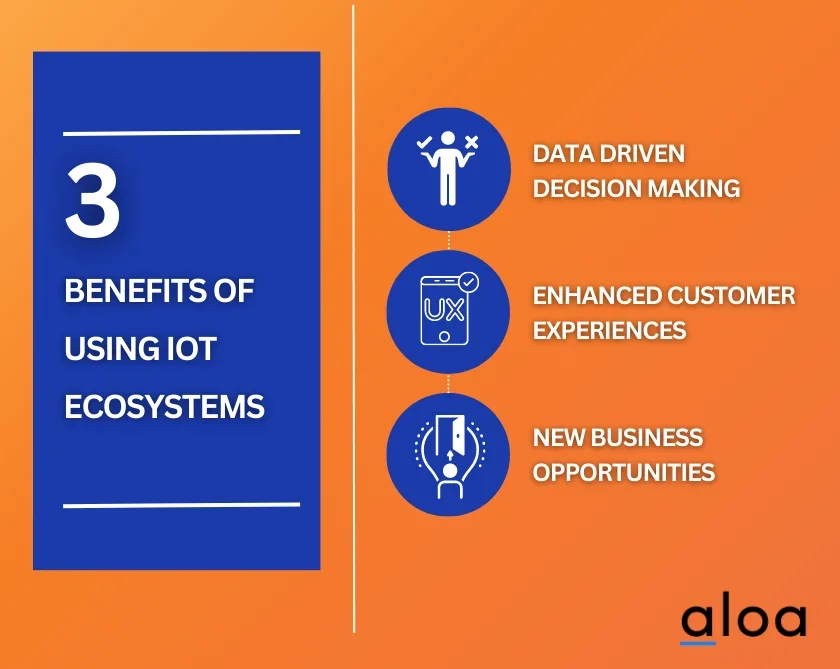
Data-Driven Decision Making
With the right analytics tools, businesses can uncover valuable insights from the data collected. Data management can enable companies to make informed decisions about optimizing their operations, automating processes, and improving customer experience. In effect, businesses can realize a cost-saving process that frees up personnel to focus on value-adding activities, resulting in cost savings over the long term.
Enhanced Customer Experiences
Internet of Things can store, analyze, and respond to customer data in real-time, allowing businesses to deliver personalized experiences that result in higher customer satisfaction. The ability to tailor customer preferences and needs can help businesses gain a competitive edge and differentiate themselves from their competitors. Additionally, companies can apply the data to creating products or services that meet customer expectations more accurately than before, increasing user satisfaction levels.
New Business Opportunities
Combining data-driven decision-making and enhanced customer experiences, businesses can identify new opportunities to expand their products or services or create new ones. Additionally, businesses can leverage IoT data for predictive analytics and forecasting future trends that could shape the industry landscape in the coming years.
By utilizing this information effectively, businesses can better understand their competitive environment and prepare accordingly. This allows them to get ahead of the competition and capture new, untapped markets. Whether you are a business that is selling canvas wall art prints or an AI driven startup, it's a new opportunity you can't miss.
Key Takeaway
To summarize this IoT Overview, Internet of Things is an emerging technology that offers businesses tremendous potential. As such, it is an opportune time for businesses to adopt IoT solutions to reap the benefits of automation, data-driven decision-making, improved customer experiences, and new business opportunities.
While it is a huge leap to take, working with the right team in implementing the necessary security protocols and safeguards can minimize any risks associated with deploying IoT solutions.
Find out how you can leverage the power of IoT to unlock new opportunities for your business by reaching out to [email protected] for access to the latest trends and developments.

